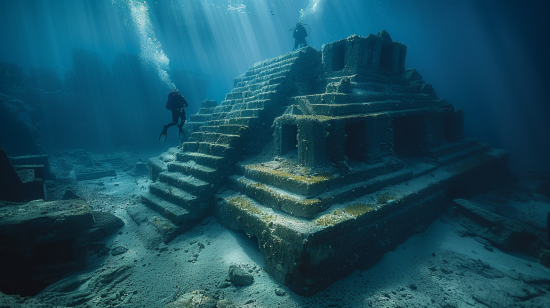Introduction
The Yonaguni Monument, an enigmatic underwater rock formation off the coast of Japan, has sparked intense debate since its discovery in 1986. Its strikingly geometric shapes and structures resemble terraces, steps, and pillars, leading some to believe it is the remnants of an ancient, submerged city. Others argue it is a natural formation sculpted by underwater currents. The true origin and purpose of the Yonaguni Monument remain a captivating mystery.
Discovery of the Yonaguni Monument
Initial Discovery
The Yonaguni Monument was discovered in 1986 by Kihachiro Aratake, a local diver exploring the waters near Yonaguni, Japan, for new diving spots. The massive stone structure he encountered was unlike anything seen before, with its sharp angles and flat surfaces.
Early Investigations
Following the initial discovery, several expeditions were launched to investigate the monument. Marine geologist Masaaki Kimura led many of these explorations, documenting the formation’s features and hypothesizing its origins. The unusual geometric shapes prompted questions about whether the monument was man-made or a natural phenomenon.
Geological Features
Description of the Monument
The Yonaguni Monument is a massive stone structure measuring about 150 meters long, 40 meters wide, and 25 meters high. Its most prominent features include flat terraces, broad steps, and right-angled formations that appear to be carved into the rock.
Geometric Shapes and Structures
The monument’s geometric shapes are its most striking feature. The large, flat terraces resemble platforms, while the broad steps suggest a grand staircase. Some formations resemble pillars and columns, further fueling speculation about their origin.
Theories of Origin
Man-Made Hypothesis
Proponents of the man-made hypothesis argue that the Yonaguni Monument is the remains of an ancient civilization. They suggest that the structure was once above water, possibly part of a city that submerged due to seismic activity or rising sea levels. The precise angles and flat surfaces are cited as evidence of human craftsmanship.
Natural Formation Theory
Critics of the man-made hypothesis believe that the monument is a natural formation. They argue that the geometric shapes could result from natural processes, such as tectonic activity and underwater currents. Similar formations have been found elsewhere, created by natural erosion.
Archaeological Significance
Artifacts and Submerged Structures
During various dives, researchers have found stone tools and other artifacts near the monument, suggesting human presence. These findings support the theory that the area may have been inhabited when sea levels were lower. However, the exact relationship between these artifacts and the monument remains unclear.
Comparative Analysis
Comparisons have been made between the Yonaguni Monument and other ancient structures, such as the pyramids of Egypt and the ziggurats of Mesopotamia. These comparisons highlight the monument’s unique features and its potential significance in understanding ancient civilizations.
Controversies and Debates
Scientific Community’s Views
The scientific community is divided over the monument’s origins. While some researchers, like Masaaki Kimura, firmly believe in its man-made origin, others remain skeptical. The lack of definitive evidence and the monument’s unique features make it difficult to reach a consensus.
Popular Theories and Speculations
Various theories and speculations have emerged regarding the monument’s purpose and origin. Some suggest it was a ceremonial site, while others propose it was part of an ancient city. These theories are often based on the monument’s size and the presence of nearby artifacts.
Cultural and Historical Context
Yonaguni’s Historical Significance
Yonaguni, the southernmost island of the Ryukyu Archipelago, has a rich history and cultural significance. The discovery of the monument adds another layer to the island’s historical narrative, potentially linking it to ancient civilizations.
Legends and Myths
Local legends and myths have also been tied to the monument. Some stories speak of a lost city beneath the waves, adding a mythical dimension to the scientific investigation. These legends reflect the monument’s impact on local culture and its enduring mystery.
Diving Expeditions and Tourism
Diving Attractions
The Yonaguni Monument has become a popular attraction for divers worldwide. Its underwater location offers a unique diving experience, with clear waters and intriguing formations to explore. Guided tours and diving expeditions are available for those interested in witnessing the monument firsthand.
Impact on Local Economy
The increased interest in the monument has positively impacted the local economy. Tourism related to the monument has brought attention to Yonaguni, boosting local businesses and promoting cultural exchange.
Technological Advances in Research
Underwater Imaging and Mapping
Technological advances in underwater imaging and mapping have allowed researchers to study the monument in greater detail. High-resolution sonar and 3D mapping techniques provide a comprehensive view of the structure, aiding in the analysis of its features.
Future Research Directions
Ongoing research aims to uncover more about the monument’s origin and purpose. Future studies may focus on detailed geological analysis, carbon dating of nearby artifacts, and further exploration of the surrounding area.
Conclusion
The Yonaguni Monument remains one of the most intriguing underwater discoveries of the 20th century. Its geometric shapes and structures continue to spark debate and speculation about its origins. Whether man-made or a natural formation, the monument offers a unique glimpse into the mysteries hidden beneath the waves. As technology advances and research continues, we may one day uncover the true story behind this enigmatic structure.
FAQs
1. What is the Yonaguni Monument?
The Yonaguni Monument is an underwater rock formation off the coast of Yonaguni, Japan. It features geometric shapes and structures that resemble terraces, steps, and pillars.
2. When was the Yonaguni Monument discovered?
The monument was discovered in 1986 by a local diver named Kihachiro Aratake.
3. Is the Yonaguni Monument man-made or natural?
The origin of the Yonaguni Monument is debated. Some researchers believe it is man-made, while others argue it is a natural formation.
4. What theories exist about the Yonaguni Monument’s purpose?
Theories about the monument’s purpose include it being part of an ancient city, a ceremonial site, or a natural geological formation.
5. Can visitors see the Yonaguni Monument?
Yes, the Yonaguni Monument is a popular diving site, attracting divers from around the world to explore its underwater features.

